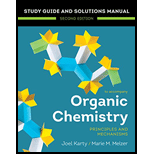
(a)
Interpretation:
Among the given pair of compounds, which compound has the polar pi bond that will undergo nucleophilic addition more rapidly is to be identified and explained.
Concept introduction:
A Nucleophilic addition reaction involves a polar
Answer to Problem 17.34P
Among the given pair of compounds, the second compound has the polar pi bond that will undergo nucleophilic addition more rapidly than the first one. This is because with fewer alkyl groups attached to the carbonyl carbon, there is less bulkiness and greater concentration of positive charge.
Explanation of Solution
The given pair of compounds are
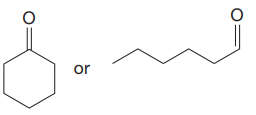
The electron-donating groups attached to the carbonyl carbon will decrease the concentration of the positive charge on the carbonyl carbon atom. In the first compound, the carbonyl carbon has two electron-donating substituents attached. In the second compound, the carbonyl carbon has only one electron-donating substituent attached. The partial positive charge on the carbonyl carbon of the second compound is greater as compared to the first one. This makes the carbonyl carbon of the second compound more electrophilic, thus, it will have more polar pi bond. Due to this, it will undergo nucleophilic addition reactions more rapidly. Due to fewer alkyl groups attached in the second compound, there is less bulkiness and hence greater contribution of a positive charge.
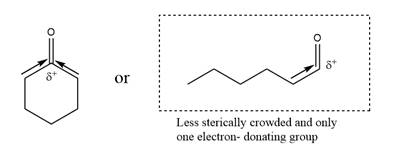
Electron-donating groups directly attached to the carbonyl carbon will decrease the concentration of a partial positive charge and make the pi bond less polar.
(b)
Interpretation:
Among the given pair of compounds, which compound has the polar pi bond that will undergo nucleophilic addition more rapidly is to be identified and explained.
Concept introduction:
A Nucleophilic addition reaction involves a polar
Answer to Problem 17.34P
Among the given pair of compounds, the second one has a more polar pi bond that will undergo nucleophilic addition more rapidly than the first one. This is because a substituent -
Explanation of Solution
The given pair of compounds are
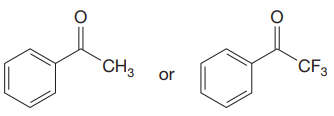
The electron-withdrawing groups attached to the carbonyl carbon will increase the concentration of the positive charge on the carbonyl carbon atom. In the first compound, the carbonyl carbon has a benzene ring at one end, and a
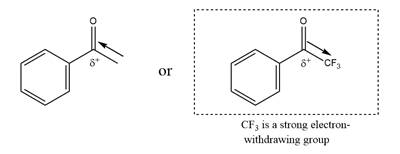
Electron-withdrawing groups directly attached to the carbonyl carbon will induce a greater concentration of a partial positive charge and make the pi bond more polar.
(c)
Interpretation:
Among the given pair of compounds, which compound has the polar pi bond that will undergo nucleophilic addition more rapidly is to be identified and explained.
Concept introduction:
A Nucleophilic addition reaction involves a polar
The concentration of the positive charge on the carbonyl carbon increases as the distance between an electron-withdrawing atom or group and the carbonyl carbon decreases.
Answer to Problem 17.34P
Among the given pair of compounds, the first one has more polar pi bond that will undergo nucleophilic addition more rapidly than the second one. This is because with the chlorine atom closer to the carbonyl carbon, the carbonyl carbon will bear a greater concentration of positive charge.
Explanation of Solution
The given pair of compounds are
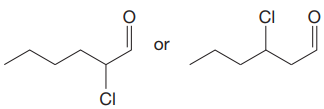
Among the given pair of compounds, the first one has more polar pi bond that will undergo nucleophilic addition more rapidly than the second one. This is because with the chlorine atom closer to the carbonyl carbon, the carbonyl carbon bears a greater concentration of positive charge. The partial positive charge on the carbonyl carbon of the first compound is greater as compared to the second one. This makes the carbonyl carbon of the first compound more electrophilic, thus, it will have more polar pi bond. Due to this, it will undergo nucleophilic addition reactions more rapidly.
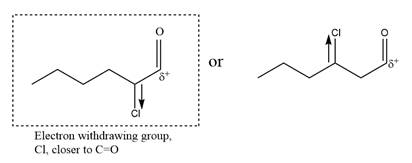
The concentration of the positive charge on the carbonyl carbon increases as the distance between an electron-withdrawing atom or group and the carbonyl carbon decreases.
(d)
Interpretation:
Among the given pair of compounds, which compound has the polar pi bond that will undergo nucleophilic addition more rapidly is to be identified and explained.
Concept introduction:
A Nucleophilic addition reaction involves a polar
Explanation of Solution
The given pair of compounds are:
![]()
Among the given pair of compounds, the first one has more polar pi bond that will undergo nucleophilic addition more rapidly than the second one. This is because the nitrile carbon bears a higher concentration of positive charge owing to the presence of the electron-withdrawing


Electron-withdrawing groups directly attached to the pi bond will induce a greater concentration of a partial positive charge and makes the pi bond more polar.
[DK1]
Want to see more full solutions like this?
Chapter 17 Solutions
EBK ORGANIC CHEMISTRY: PRINCIPLES AND M
- Epoxides can be opened in aqueous acid or aqueous base to produce diols (molecules with two OH groups). In this question, you'll explore the mechanism of epoxide opening in aqueous acid. 2nd attempt Be sure to show all four bonds at stereocenters using hash and wedge lines. 0 0 Draw curved arrows to show how the epoxide reacts with hydronium ion. 100 +1: 1st attempt Feedback Be sure to show all four bonds at stereocenters using hash and wedge lines. See Periodic Table See Hint H A 5 F F Hr See Periodic Table See Hintarrow_forward03 Question (1 point) For the reaction below, draw both of the major organic products. Be sure to consider stereochemistry. > 1. CH₂CH₂MgBr 2. H₂O 3rd attempt Draw all four bonds at chiral centers. Draw all stereoisomers formed. Draw the structures here. e 130 AN H See Periodic Table See Hint P C Brarrow_forwardYou may wish to address the following issues in your response if they are pertinent to the reaction(s) you propose to employ:1) Chemoselectivity (why this functional group and not another?) 2) Regioselectivity (why here and not there?) 3) Stereoselectivity (why this stereoisomer?) 4) Changes in oxidation state. Please make it in detail and draw it out too in what step what happens. Thank you for helping me!arrow_forward
- 1) Chemoselectivity (why this functional group and not another?) 2) Regioselectivity (why here and not there?) 3) Stereoselectivity (why this stereoisomer?) 4) Changes in oxidation state. Everything in detail and draw out and write it.arrow_forwardCalculating the pH at equivalence of a titration 3/5 Izabella A chemist titrates 120.0 mL of a 0.7191M dimethylamine ((CH3)2NH) solution with 0.5501 M HBr solution at 25 °C. Calculate the pH at equivalence. The pk of dimethylamine is 3.27. Round your answer to 2 decimal places. Note for advanced students: you may assume the total volume of the solution equals the initial volume plus the volume of HBr solution added. pH = ☐ ✓ 18 Ar Boarrow_forwardAlcohols can be synthesized using an acid-catalyzed hydration of an alkene. An alkene is combined with aqueous acid (e.. sulfuric acid in water). The reaction mechanism typically involves a carbocation intermediate. > 3rd attempt 3343 10 8 Draw arrows to show the reaction between the alkene and hydronium ion. that 2nd attempt Feedback 1st attempt تعمال Ju See Periodic Table See Hint F D Ju See Periodic Table See Hintarrow_forward
- Draw the simplified curved arrow mechanism for the reaction of acetone and CHgLi to give the major product. 4th attempt Π Draw the simplified curved arrow mechanism T 3rd attempt Feedback Ju See Periodic Table See Hint H -H H -I H F See Periodic Table See Hintarrow_forwardSelect the correct reagent to accomplish the first step of this reaction. Then draw a mechanism on the Grignard reagent using curved arrow notation to show how it is converted to the final product. 4th attempt Part 1 (0.5 point) Select the correct reagent to accomplish the first step of this reaction. Choose one: OA Mg in ethanol (EtOH) OB. 2 Li in THF O C. Li in THF D. Mg in THF O E Mg in H2O Part 2 (0.5 point) Br Part 1 Bri Mg CH B CH, 1 Draw intermediate here, but no arrows. © TE See Periodic Table See Hint See Hint ין Harrow_forwardSelect the product for the following reaction. HO HO PCC OH ○ OH O HO ○ HO HO HOarrow_forward
- 5:45 Х Select the final product for the following reaction sequence. O O 1. Mg. ether 2.D.Oarrow_forwardBased on the chart Two similarities between the molecule with alpha glycosidic linkages. Two similarities between the molecules with beta glycosidtic linkages. Two differences between the alpha and beta glycosidic linkages.arrow_forwardplease help fill in the tablearrow_forward
 Organic Chemistry: A Guided InquiryChemistryISBN:9780618974122Author:Andrei StraumanisPublisher:Cengage Learning
Organic Chemistry: A Guided InquiryChemistryISBN:9780618974122Author:Andrei StraumanisPublisher:Cengage Learning
 Chemistry for Today: General, Organic, and Bioche...ChemistryISBN:9781305960060Author:Spencer L. Seager, Michael R. Slabaugh, Maren S. HansenPublisher:Cengage Learning
Chemistry for Today: General, Organic, and Bioche...ChemistryISBN:9781305960060Author:Spencer L. Seager, Michael R. Slabaugh, Maren S. HansenPublisher:Cengage Learning


